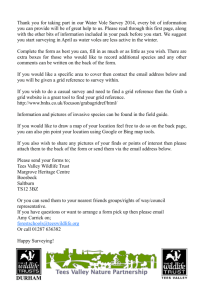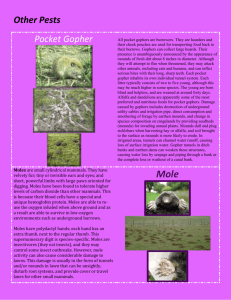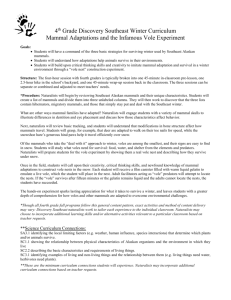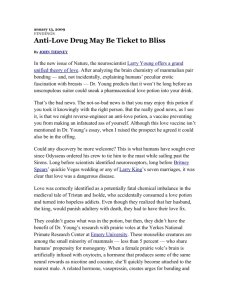Morphometric shape analysis using learning vector quantization
advertisement
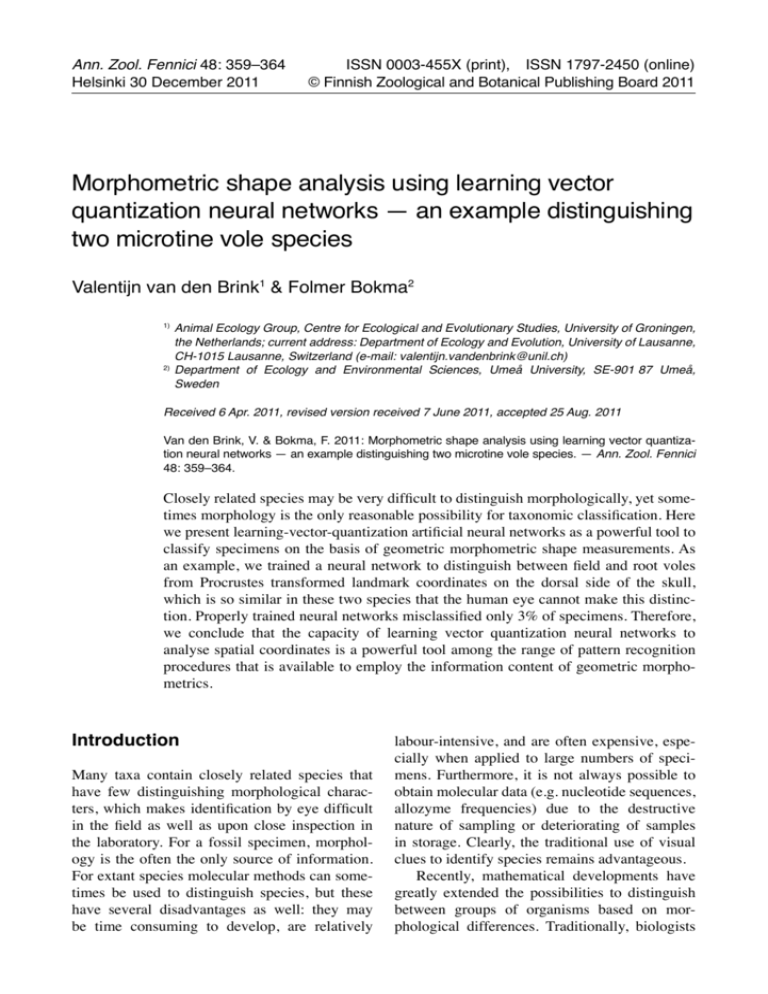
Ann. Zool. Fennici 48: 359–364 Helsinki 30 December 2011 ISSN 0003-455X (print), ISSN 1797-2450 (online) © Finnish Zoological and Botanical Publishing Board 2011 Morphometric shape analysis using learning vector quantization neural networks — an example distinguishing two microtine vole species Valentijn van den Brink1 & Folmer Bokma2 Animal Ecology Group, Centre for Ecological and Evolutionary Studies, University of Groningen, the Netherlands; current address: Department of Ecology and Evolution, University of Lausanne, CH-1015 Lausanne, Switzerland (e-mail: valentijn.vandenbrink@unil.ch) 2) Department of Ecology and Environmental Sciences, Umeå University, SE-901 87 Umeå, Sweden 1) Received 6 Apr. 2011, revised version received 7 June 2011, accepted 25 Aug. 2011 Van den Brink, V. & Bokma, F. 2011: Morphometric shape analysis using learning vector quantization neural networks — an example distinguishing two microtine vole species. — Ann. Zool. Fennici 48: 359–364. Closely related species may be very difficult to distinguish morphologically, yet sometimes morphology is the only reasonable possibility for taxonomic classification. Here we present learning-vector-quantization artificial neural networks as a powerful tool to classify specimens on the basis of geometric morphometric shape measurements. As an example, we trained a neural network to distinguish between field and root voles from Procrustes transformed landmark coordinates on the dorsal side of the skull, which is so similar in these two species that the human eye cannot make this distinction. Properly trained neural networks misclassified only 3% of specimens. Therefore, we conclude that the capacity of learning vector quantization neural networks to analyse spatial coordinates is a powerful tool among the range of pattern recognition procedures that is available to employ the information content of geometric morphometrics. Introduction Many taxa contain closely related species that have few distinguishing morphological characters, which makes identification by eye difficult in the field as well as upon close inspection in the laboratory. For a fossil specimen, morphology is the often the only source of information. For extant species molecular methods can sometimes be used to distinguish species, but these have several disadvantages as well: they may be time consuming to develop, are relatively labour-intensive, and are often expensive, especially when applied to large numbers of specimens. Furthermore, it is not always possible to obtain molecular data (e.g. nucleotide sequences, allozyme frequencies) due to the destructive nature of sampling or deteriorating of samples in storage. Clearly, the traditional use of visual clues to identify species remains advantageous. Recently, mathematical developments have greatly extended the possibilities to distinguish between groups of organisms based on morphological differences. Traditionally, biologists 360 measured and described morphology in terms such as size, length, weight, and angles. Since the early 1980s, a new way of analysing morphological data has been increasingly used, which preserves the shape of samples during analysis. This new method — geometric morphometrics — analyses the geometric configuration of a set of corresponding points on each specimen under study (Rohlf & Marcus 1993, Bookstein 1996, Adams et al. 2004). These points, often placed at diagnostic sites, are called landmarks, a term borrowed from craniometry and previously from topographic surveying. The analyses of these data use mathematical definitions of shape. The shape incorporates all features of the landmarks, except for size, position and orientation. A socalled Procrustes transformation can remove these factors from the specimens, making the data suitable for standard multivariate analyses. (For a comprehensive review see e.g. Adams et al. 2004, Zelditch et al. 2004). The removal of size is achieved by scaling all samples to the same (unit) size by dividing by centroid size (i.e. combined distances of landmarks to their joint centre of gravity). Subsequently, position is removed by superimposing the centroids of all samples. Finally, orientation is removed when all samples are rotated so as to minimize distances between corresponding landmarks between individuals (For statistical background of the process see Zelditch et al. 2004). The remaining variation in landmark coordinates is variation in shape, and can be used as input for standard multivariate statistics. Geometric morphometrics possess two important advantages over traditional methods: The first is their ability to represent results graphically, which allows easy interpretation of their relation to the object under study. Second is their remarkable statistical power, enabling detection of even very small phenotypic differences. Although geometric morphometrics provides a powerful means to measure shape differences, it is not in itself a method to distinguish between species (or taxa of other rank). Because statistical methods have long been developed for traditional morphometrics (measurements of lengths, volumes, and angles), few statistical approaches are available to directly interpret geometric morphometric measurements. Therefore, morpho- Van den Brink & Bokma • ANN. ZOOL. FENNICI Vol. 48 metric measurements are often transformed, for example into principle components, before further statistical analysis. Such transformations, however, remove the attractive visual feature of geometric morphometrics of representing measurements graphically. In addition, transformation may reduce the statistical power of morphometrics. Therefore, it is worthwhile to develop methods to directly interpret geometric morphometric measurements (Dobigny et al. 2002, Baylac et al. 2003, Cordeiro-Estrela et al. 2008). Here, we explain how a recently developed statistical tool — learning-vector-quantization artificial neural networks (Kohonen 1995) — could be used to employ the power of geometric morphometrics to distinguish between taxa, for example populations or species. We illustrate the power of this approach by training a neural network to distinguish two vole species, Microtus agrestis and M. oeconomus from the dorsal side of the skull, a feature previously thought unsuitable for distinguishing these morphologically virtually identical species. Methods The microtine vole species agrestis and oeconomus are morphologically and ecologically similar, and have largely overlapping geographical distributions, both at large and small spatial scales. Typically, the only certainly distinctive morphological feature is the 1st molar of the upper jaw, which differs in the number of planes between the species. Their strikingly similar morphology and partly overlapping niches appear to be due to convergent evolution, as the species are not sibling species. Despite their similarities, the field vole Microtus agrestis is thriving, widely distributed, and sometimes even regarded a pest, while the root vole populations have become increasingly fragmented, reduced throughout its southern range, and some subspecies are severely threatened in their existence. Because of its red-listed status (Gippoliti 2002) due to a scattered occurrence in its nowadays limited geographic range, the root vole subspecies Microtus oeconomus arenicola has been subject of genetic studies to obtain insight in the effective sizes and degree of iso- ANN. ZOOL. FENNICI Vol. 48 • Neural network analysis of morphometric shape lation of local populations (Leijs et al. 1999, Van de Zande et al. 2000). Genetic studies that rely on blood samples require trapping of animals, which causes disturbance. An alternative method, causing fewer disturbances, is to extract DNA from the bony remains of voles encountered in regurgitated owl pellets (Woodward et al. 1994, Taberlet & Fumagalli 1996, Poulakakis et al. 2005). In theory, pellets of the barn owl (Tyto alba) could be useful: it occurs throughout the distribution area of M. o. arenicola, has a limited home range, and often builds its nest in buildings (which facilitates collection of pellets). However, owls that prey on root voles also prey on field voles. Since field voles are much more abundant, most bony remains in pellets stem from field voles, making it highly desirable to distinguish root vole remains before labourintensive and expensive genotyping analyses. We obtained skull samples retrieved from barn owl pellets. These pellets were collected over a number of years and at various sites in the Netherlands. Skulls from pellets were cleaned with a brush, and remaining hair and mud were removed with a pair of tweezers. Each skull was photographed from dorsal view with a tripod mounted digital camera. The digital images were placed in random order using the program TpsUtil 1.34 (Rohlf 2005) before marking landmarks using TpsDig version 2.05 software (Rohlf 2006). We used eight of the landmarks used by Ràcz et al. (2005) in their study of the root vole, plus two extra, all located on the front half dorsal side of the skull (Fig. 1). (The landmarks that Ràcz et al. (2005) located on the rear half of the skull could not be used, since barn owls usually bite off this part before swallowing the vole.) The landmarks were located either on the fissurepoints of bones or on curve points or tips of the skull. The complete representation of landmark locations is shown in Fig. 1. Artificial neural networks Artificial neural networks, as a simplified analogy to the human brain, consist of layers of neurons. Neurons convert input to output and neurons in different layers are connected so that 361 Fig. 1. Position of landmarks used for morphometric analysis on the dorsal side of a Microtus skull (upper panel). The owl usually bites off the area at the back of the skull indicated by grey shading, and therefore no landmarks were placed in that area. Lower panel: landmark coordinates of 405 root voles Microtus oeconomus (grey) and 40 field voles M. agrestis (black) after Procrustes transformation. (generally) the output of the first layer neurons is input for the next layer. The first layer receives its inputs from the investigator, who gets in return the output of the final layer. Artificial neural networks can be designed with different numbers of layers, different numbers of neurons per layer, and neurons can use different mathematical functions to convert input into output. The numbers of layers, neurons, and types of transfer functions determine the suitability of a neural network for a particular task. By providing an example set of inputs and desired outputs, the investigator can teach a neural network to perform a specific conversion of input into output. Mathematically this involves adjusting the parameters of the functions that neurons use to convert input into output in such a way that the network as a whole shows the desired behaviour. Because of this, artificial neural networks are very flexible statistical tools, nowadays often used as universal function approximators. There exist numerous types of artificial neural networks and methods to tune them, so 362 Van den Brink & Bokma • ANN. ZOOL. FENNICI Vol. 48 Fig. 2. Scores of 58 root voles Microtus oeconomus (black) and 39 root voles Microtus agrestis (grey) on the first three principle components of landmark positions. The scores of another two root voles and another field vole that were misclassified are highlighted with open circles. that we cannot give here an in-depth treatment of the functioning and use of neural networks. Instead we refer the reader to general textbooks. Here, only two types of neural networks are of interest: competitive layers and learning vector quantization (LVQ) networks (Kohonen 1995). Competitive layers are networks that recognize similarity of input, and group input on the basis of this similarity in subclasses. The investigator has little influence on the grouping, except on the number of subclasses. Competitive layers can, for example, recognize similarity in the landmark locations of some vole skulls and group the skulls according to that similarity. A LVQ network consists of two layers: first a competitive layer (introduced above) followed by a linear layer. When the competitive layer has placed skulls in subclasses based on landmark coordinates, the linear layer subsequently transforms the subclasses into user-defined target classes, i.e. species classification. Thus the competitive layer groups the individual voles according to their similarity in landmark coordinates (a process on which the researcher has little influence) after which the linear layer is trained to group subclasses into the species classification as defined by the researcher. Results Landmark coordinates of 405 root voles and 40 field voles after Procrustes transformation (Zelditch et al. 2004) show the similarity in shape of the two species studied here (Fig. 1). The loca- tions of some landmarks appear to differ systematically between the species to some extent, whereas others appear to have no diagnostic value. Importantly, all landmark coordinates display considerable overlap between the two species, so that no single landmark is diagnostic for the root- versus field-vole classification. Also, none of the first three principle components of the landmark positions, nor any combination of these, distinguishes between the species (Fig. 2). For the following analyses we used 40 field vole skulls and a random subset of 60 root vole skulls (out of the 405 shown in Fig. 1). From these 100 skulls, 80 were randomly selected to train a LVQ network, the performance of which was subsequently evaluated on the remaining 20 skulls, which the network had not seen during training. For comparison, we also classified the specimens using linear discriminant functions. Because classification performance may depend on which skulls were selected for training, we repeated the selection and classification procedure 1000 times. We used Matlab 7.5 (Mathworks, MA, USA) for all classification analyses. A simple LVQ network classifying landmark coordinates into four subclasses was sufficient for species classification. For one random assignment of the 100 skulls to training and test sets, two root voles were misclassified as field voles, and conversely one field vole was misclassified as root vole (Fig. 2). Somewhat unexpectedly all misclassifications occurred in the training set: the 20 skulls in the evaluation set were all correctly classified. When we repeated the random assignment 1000 times, the learning vector quan- ANN. ZOOL. FENNICI Vol. 48 • Neural network analysis of morphometric shape tization network misclassified on average 3.9% of the root voles in the test set as field voles, and 3.2% of field voles as root voles. (Similar results were obtained with two and four subclasses.) For comparison, discriminant function analysis misclassified on average 0.9% of the root voles in the test set as field voles, and 3.3% of field voles as root voles. Discussion In this study, we were aware of the correct species status of our specimen, because the 1st molar of the upper jaw distinguishes the species, and it may seem strange to apply neural network analysis to morphometric data when a distinguishing character is readily available. However, had we not known the correct classification of our samples, we could not have evaluated the accuracy of the method we are presenting. Cases like the present, where an investigator has a number of specimen for which the correct classification is known and which can be used to train the neural network, may occur in various situations. For example, some vole skulls retrieved from owl pellets lack the distinguishing molar in the upper jaw. In fossil studies, more complete fossils may be assigned to lineages, while the assignment of incomplete remains is uncertain. In studies of present-day species, some individuals may be assigned to populations using karyotypic or molecular data. In cases where no certain assignments can be made at all, a competitive layer neural network alone may be used to group the specimen into a user-defined number of categories. In a previous study, Dobigny et al. (2002) used artificial neural networks to interpret morphometric data in an attempt to distinguish between sibling species of Taterillus (Rodentia, Gerbillinae) species that could previously be identified unambiguously only from their karyotypes. In their study, cross-validated classification rates did not exceed 73%. It is difficult to say what causes the classification success to differ between studies. First and foremost, classification success will always depend on the magnitude of phenotypic differences, and on whether the landmarks were placed so as to capture these 363 differences. If the skulls of root and field voles studied here were morphologically more distinct than those of the Taterillus species studied by Dobigny et al. (2002) that would certainly explain part of the difference in classification success. Second, Dobigny et al. (2002) studied four species, which may pose a greater challenge than our distinction between just two species. Finally, it is possible that classification success is higher in the present study because the learning vector quantization networks we used are generally more appropriate to interpret spatial data such as landmarks. Even though some methods and algorithms may be generally more sensitive and better suitable to distinguish specimens than other methods, it is not to be expected that any one method generally outcompetes all others (Van Bocxlaer & Schultheiß 2010). Rather, it seems plausible that the relative performance of alternative procedures depends on the kind of data being analysed. Therefore, we do not recommend LVQ as a replacement for any alternative method. In cases where classification is difficult, we instead suggest an approach where different classification methods, such as discriminant function analysis and LVQ are combined to improve classification accuracy. For example, in the present study LVQ performed slightly better than discriminant function analysis in recognizing field voles, but the opposite was the case for root voles. Also, the alternative methods often misclassified different specimens, which implies that a combination of the two methods provides better classification than either method alone. As an additional parameter, LVQ neural networks require the investigator to specify the typical frequencies of output classes. In the present case where we trained a network on 40 field vole and 60 root vole skulls these percentages would have been 40% and 60%. These typical class frequencies allow the investigator to bias the classification, if bias is desired. For example, had we aimed to minimize genotyping costs in a root vole study, we could have minimized the number of field vole samples misclassified as root voles by modifying the typical class frequencies to, for example, 10% and 90%. This strategy would, however, also result in more root voles being misclassified as field voles. If, on the other hand, 364 we had wanted to make sure that no root vole was missed in the analyses, we could have modified the expected frequencies to be for example 90% and 10%. This on the other hand would have resulted in more field voles being misclassified as root voles. Several techniques of pattern recognition have now been applied to the problem of classifying specimens based on geometric morphometric data (Baylac et al. 2003, Cordeiro-Estrela et al. 2008). We conclude that the suitability of LVQ networks to analyse spatial coordinates is a useful extension to the demonstrated sensitivity of geometric morphometrics to small differences in shape. Available software packages render artificial neural network analysis so easy that also biologists without advanced statistical skills can perform these analyses. Acknowledgements We thank the Dutch society for the study and protection of mammals VZZ, in particular W. Spijkstra, K. Mostert , and Dick Becker; the zoological museum of the University of Oulu, Finland, in particular Risto Tornberg; and the Dutch barn owl study group, in particular Johan de Jong. Without their efforts and expertise we could not have done this study. We also thank Dr. H. D. Sheets for insightful and helpful comments on an earlier draft of this paper. This study was supported by the Swedish research council. References Adams, D. C., Rohlf, J. F. & Slice, D. E. 2004: Geometric morphometrics: ten years of progress following the ‘Revolution’. — Italian Journal of Zoology 71: 5–16. Baylac, M., Villemant, C. & Simbolotti, G. 2003: Combining geometric morphometrics with pattern recognition for the investigation of species complexes. — Biological Journal of the Linnean Society 80: 89–98. Bookstein, F. L. 1996: Biometrics, biomathematics and the morphometric synthesis. — Bulletin of Mathematical Biology 58: 313–365. Cordeiro-Estrela, P., Baylac, M., Denys, C. & Polop, J. 2008: Combining geometric morphometrics and pattern recog- Van den Brink & Bokma • ANN. ZOOL. FENNICI Vol. 48 nition to identify interspecific patterns of skull variation: case study in sympatric Argentinian species of the genus Calomys (Rodentia: Cricetidae: Sigmodontinae). — Biological Journal of the Linnean Society 94: 365–378. Dobigny, G., Baylac, M. & Denys, C. 2002: Geometric morphometrics, neural networks and diagnosis of sibling Taterillus species (Rodentia, Gerbillinae). — Biological Journal of the Linnean Society 77: 319–327. Gippoliti, S. 2002: Microtus oeconomus ssp. arenicola. — In: 2006 IUCN Red List of Threatened Species, available at www.iucnredlist.org. Kohonen, T. 1995: Self-organizing maps. — Springer-Verlag, Heidelberg. Leijs, R., Van Apeldoorn, R. C. & Bijlsma, R. 1999: Low genetic differentiation in north-west European populations of the locally endangered root vole, Microtus oeconomus. — Biological Conservation 87: 39–48. Poulakakis, N., Lymberakis, P., Paragamian, K. & Mylonas, M. 2005: Isolation and amplification of shrew DNA from barn owl pellets. — Biological Journal of the Linnean Society 85: 331–340. Ràcz, G. R., Gubànyi, A. & Vozàr, À. 2005: Morphometric differences among root vole (Muridae, Microtus oeconomus) populations in Hungary. — Acta Zoologica Academiae Scientiarum Hungaricae 51: 135–149. Rohlf, F. J. 2005: tpsUtil, file utility program, ver. 1.34. — Department of Ecology and Evolution, State University of New York at Stony Brook. Rohlf, F. J. 2006: tpsDig, digitize landmarks and outlines, ver. 2.05. — Department of Ecology and Evolution, State University of New York at Stony Brook. Rohlf, F. J. & Marcus, L. F. 1993. A revolution in morphometrics. — Trends in Ecology and Evolution 8: 129–132. Taberlet, P. & Fumagalli, L. 1996: Owl pellets as a source of DNA for genetic studies of small mammals. — Molecular Ecology 5: 301–305. Van Bocxlaer, B. & Schultheiß, R. 2010: Comparison of morphometric techniques for shapes with few homologous landmarks based on machine-learning approaches to biological discrimination. — Paleobiology 36: 497–515. Van de Zande, L., Van Apeldoorn, R. C., Blijdenstein, A. F., De Jong, D., Van Delden, W. & Bijlsma, R. 2000: Microsatellite analysis of population structure and genetic differentiation within and between populations of the root vole, Microtus oeconomus in the Netherlands. — Molecular Ecology 9: 1651–1656. Woodward, S. R., King, M. J., Chiu, N. M., Kuchar, M. J. & Griggs, C. W. 1994: Amplification of ancient nuclear DNA from teeth and soft tissues. — PCR-methods and applications 3: 244–247. Zelditch, M. L., Swiderski D. L., Sheets, D. H. & Fink, W. L. 2004. Geometric morphometrics for biologists. — Elsevier Academic Press, New York and London. This article is also available in pdf format at http://www.annzool.net/
